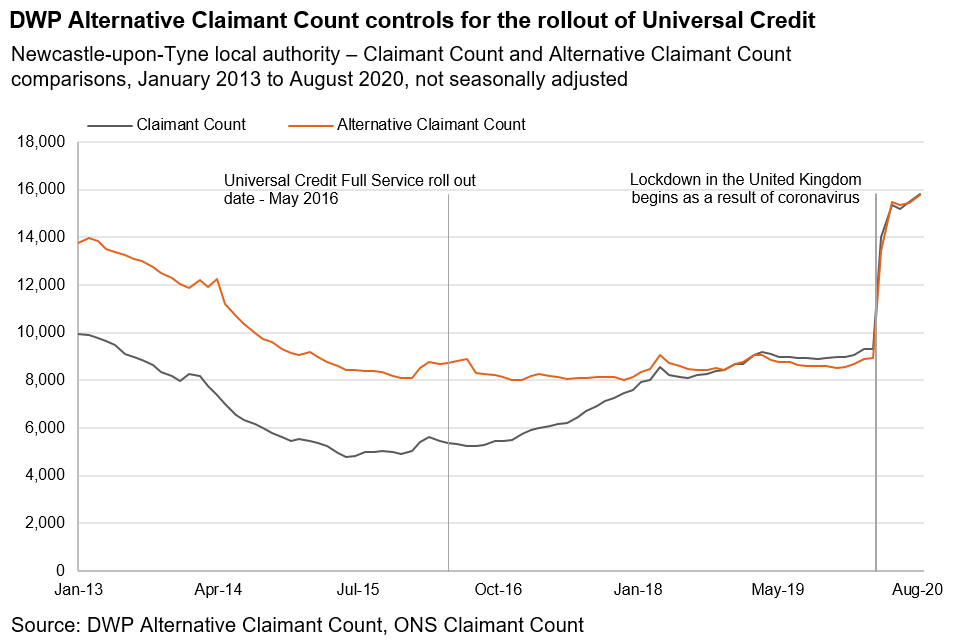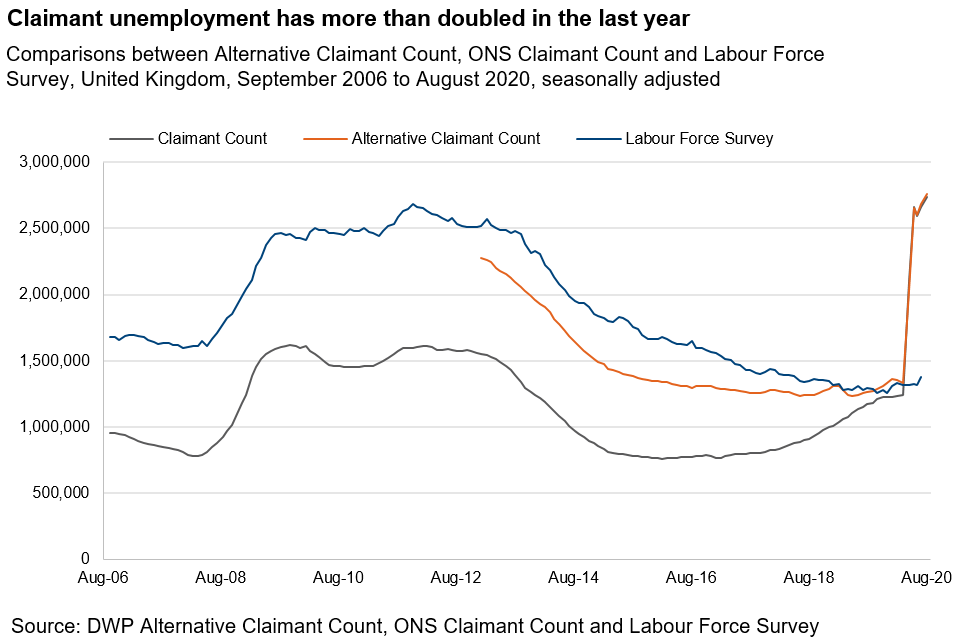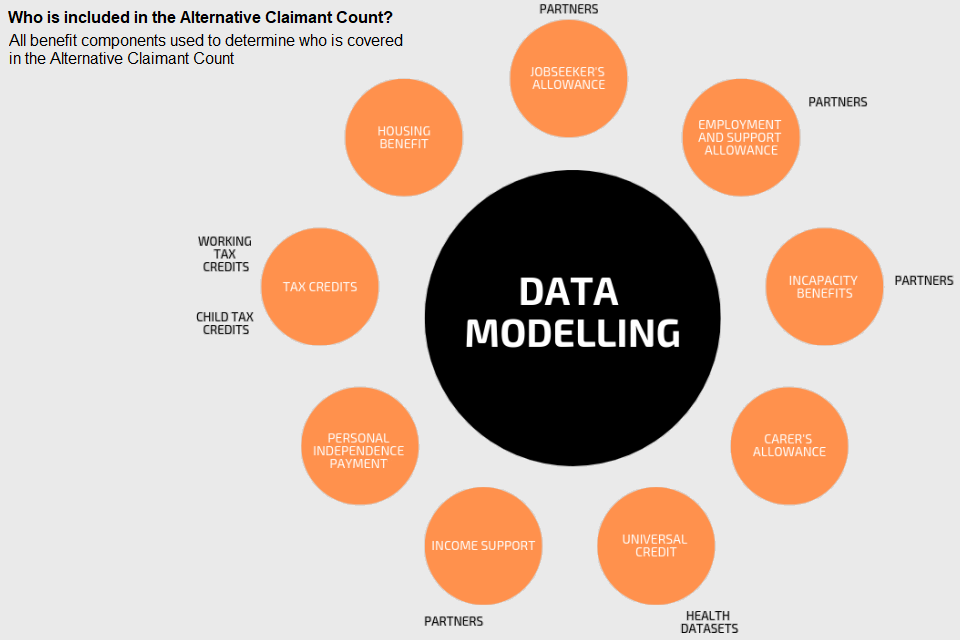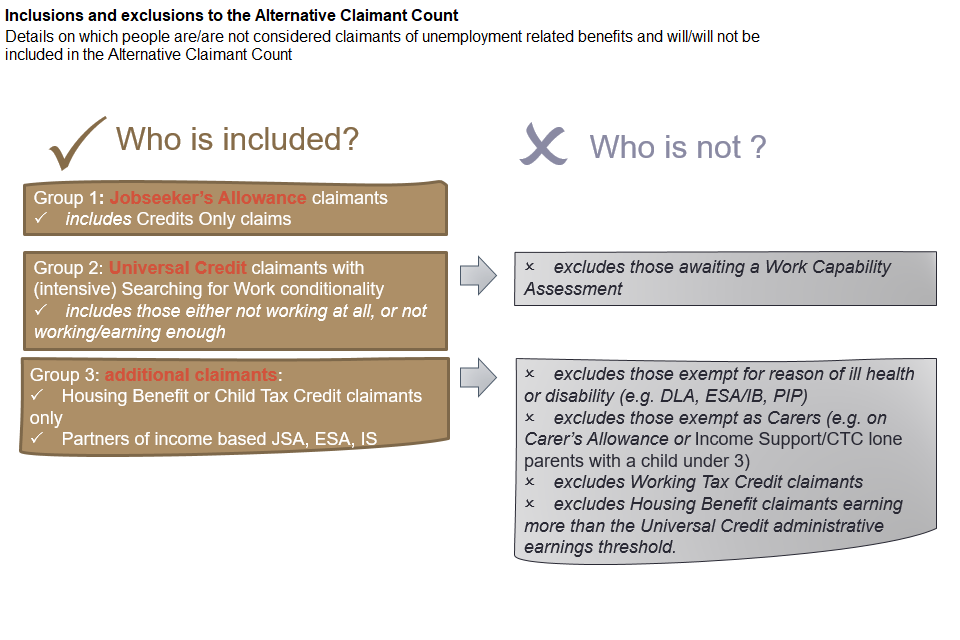Alternative Claimant Count statistics: background information and methodology
Updated 13 October 2020
1. Context
Under Universal Credit, a broader span of claimants are required to look for work than under Jobseeker’s Allowance. This has the effect of increasing the Claimant Count and Office for National Statistics (ONS) have stated that the figures are no longer a reliable economic indicator.
To address this, the new Alternative Claimant Count statistics measure the number of people claiming unemployment benefits by modelling what the count would have been if Universal Credit had been in place since 2013 with the broader span of people this covers.
The statistics provide a consistent measure of local levels of unemployed claimants over time and across areas and a better indication of labour market change. These statistics do not replace the Claimant Count but, given the implementation of Universal Credit and the natural increases to the Claimant Count that this brings, the statistics do provide a:
- consistent unemployed claimant series
- better indicator of local labour market change over time than the Claimant Count
To understand the impact of the differences between the two measures, Newcastle-upon-Tyne (which was one of the first local authorities to roll out Universal Credit Full Service to new claimants in May 2016) shows a sharp rise in claimant unemployment as more people were brought into Searching for Work conditionality. But this was irrespective of changes in the local labour market and gave misleading rises in local unemployment estimates, which the Alternative Claimant Count controls for and shows a much flatter trend.

The Claimant Count is a measure of the number of people claiming unemployment related benefits. Before 2013 this was simply the number of people claiming Jobseeker’s Allowance.
Since the introduction of Universal Credit from April 2013 the Claimant Count is measured as the number of people claiming Jobseeker’s Allowance and the number of Universal Credit claimants placed in the ‘Searching for Work’ conditionality group.
However, as more people are brought within the coverage of the Claimant Count, the Claimant Count is set to rise noticeably over time. This will happen irrespective of how the economy performs and is a feature of the design of Universal Credit which brings additional groups of people into ‘Searching for Work’ conditionality (for example partners of claimants, people who previously only claimed Housing Benefit or Child Tax Credits) to help encourage and support these claimants into work.
As a result, the ONS withdrew the Claimant Count from their national Labour Market Statistics Bulletin in March 2017, stating that the Claimant Count was no longer a reliable economic indicator. ONS stated that the change in composition of the count could leave users with a misleading representation of changes in the labour market.
To address this, these new statistics show the number of people claiming unemployment related benefits comprising:
- Jobseeker’s Allowance.
- Universal Credit – Searching for Work conditionality (excluding those on the health journey pre-Work Capability Assessment).
- Estimates of those additional claimants who would have been Searching for Work under Universal Credit had it existed over the entire time period from 2013.
This consistent unemployed claimant series thus provides a better indicator of local labour market change over time than the Claimant Count.
A public consultation asking users how these new statistics should be constructed and published was run in May 2018. Read the results of this consultation and the resulting publication strategy.
This strategy outlines the scope and purpose of the statistics and summarises responses from users to the consultation. This new statistical series lifts the historic Claimant Count to what it would have been under a “Universal Credit world” and thus provides a consistent measure of labour market change at a local level over time.
The original research and consultation report aimed to:
- Summarise options for a new experimental statistical series (in addition to the Claimant Count) which gives a consistent picture of national and local labour market conditions over time.
- Seek the views of users on these options, and the scope of any new experimental statistics (part 2 – see separate questionnaire).
The consultation on an alternative Claimant Count statistical series ran for 8 weeks from 21 May to 21 July 2018 and asked for feedback on the:
- construction of a new statistical series
- scope of the statistics and how they are released (frequency and timeliness)
- statistical products published by DWP
2. Purpose
The consultation has proven to be a successful endeavour – as well as gaining views from a wider range of users on a new series, it has proven valuable in better understanding why and how users use the Claimant Count and, linked to the value pillar of official statistics, it gives a strong basis for investing the time and resource to develop and publish a new series.
Users explained how and why they used Claimant Count statistics. By broad theme these were for:
- service resource planning (for example, Jobcentre Plus staffing levels and programme provision) and local profiling
- targeting skills and employment interventions
- aid to interpretation of Indices of Multiple Deprivation
- allocations of capital funds to local areas
- performance indicators for local economy
- economic and labour market briefing at national and local level, for example for MPs and Councillors
- forecasting, for example Bank of England short-term forecasts
- costing Manifesto commitments
- monitoring and assessment of local and national strategies and programmes
- supporting tender specifications
3. Limitations
As with the Claimant Count, these new statistics do not measure unemployment, as defined by the International Labour Organisation. They measure the number of people claiming unemployment related benefits. This will not cover all of the people who meet the ILO definition, which is measured using the Labour Force Survey.
Data: The statistics form a modelled statistical series. The statistics are formed as a count of the number of people claiming a benefit that is – or would be under Universal Credit – related to being actively available and searching for work, that is the number of people claiming Jobseeker’s Allowance (JSA), or Universal Credit Searching for Work conditionality (excluding those on the health journey pre-Work Capability Assessment), or a legacy benefit or Child tax Credit that would under Universal Credit place the claimant with Searching for Work conditionality. This latter group are termed “additionals”.
Prior to April 2015, Universal Credit conditionality group was not available and thus the statistics do not include a small number of Universal Credit Searching for Work claimants before April 2015.
The JSA and Universal Credit elements of the series are largely drawn from official statistics published on these benefits. However, the “additionals” component is a modelled series and relies on a number of assumptions which rely on use of data on in and out of work status and earnings, proxied by Housing Benefit and Tax Credit returns.
The statistics also draw upon new and evolving datasets, such as Universal Credit Work Capability Assessment cases. Those claimants awaiting a Work Capability Assessment are removed from the statistics.
The series has been derived from January 2013 onwards. Prior to this date, not all data is available to consistently model earlier years. In particular data on claimants address history.
The claimant unemployment rates use resident 16 to 64 population estimates as the denominator. The latest published mid-year estimates are for June 2018.
Statistics on monthly flows onto and from the Count have been published for the first time in October 2019. These statistics are available by month (February 2013 to August 2019), by local area, by benefit type, and by age or gender. They offer some insights to users on “churn” in a local area – for example the proportion of the Count which represents new claims, and the off-flow rate; a measure of how the local labour market is performing.
Onflows: the number of people claiming unemployment related benefits in month t, who were not claiming in the previous month (t-1).
Off-flows: the number of people no longer claiming unemployment related benefits in month t, who were claiming in the previous month (t-1).
Statistics for Northern Ireland were published for the first time in January 2020, thus the headline statistics now relate to UK rather than GB coverage.
Statistics are seasonally adjusted and standardised to control for 4 and 5 week counting periods.
Frequency of publication and timeliness: The statistics are pre-announced for release on a quarterly basis, and with a 2-month lag between the publication date and the Count date. Thus the statistics are both published less frequently than the monthly Claimant Count, and are less timely than the Claimant Count. This is a reflection of the significant level of additional complexity associated with derivation of the new series which relies on processing of data not just for JSA and Universal Credit claimants, but also for legacy benefits and Tax Credits and partners information to model “additionals”.
Credibility of the series: There is an inherent assumption used in the model on “equivalent take-up” by “additionals” of Universal Credit. Namely that the model assumes “additionals” whose circumstances suggest that they would be Searching for Work under Universal Credit, do in reality migrate to Universal Credit – all other circumstances being unchanged. The statistics provide a best-estimate and a consistent estimate of this transition.
Any future changes to Universal Credit policy that introduce new groups of additional claimant within Searching for Work conditionality will mean that the statistical back-series may need to be adjusted to ensure consistency over time. It is possible that annual adjustments to the series may be required.
4. Comparisons
Under Universal Credit, jobseeker’s who would have previously claimed JSA are included in the ‘Searching for Work’ conditionality group and included in the ONS Claimant Count. However, this conditionality group contains a broader span of claimants than under JSA definitions, for example:
- partners of claimants
- people who previously would have only received Housing Benefit or Child Tax Credits
- people who are awaiting a Work Capability Assessment under Universal Credit
Since the expansion of Universal Credit to all claimant types from May 2016, these ‘additional claimants’ become increasingly visible, with significant increases in areas where jobcentres have moved to Universal Credit Full Service.
This policy decision has the effect of bringing additional people into the Claimant Count compared to the pre-Universal Credit world and consequently the Claimant Count is less reliable as an indicator of changes in labour market performance at both a local and national level.
As a result, the ONS withdrew the Claimant Count from their national Labour Market Statistics Bulletin in March 2017, stating that the Claimant Count was no longer a reliable economic indicator. As well as altering its usefulness as an economic and labour market indicator, the inclusion of additional claimant groups within ‘Searching for Work’ conditionality has also led to a change in the designation of the Claimant Count statistics.
ONS firstly – on 17 June 2015 – removed the designation of National Statistic, leaving the Claimant Count with an experimental statistics designation; and later, on 23 February 2017, withdrew the Claimant Count from their national Labour Market Statistics Bulletin until further notice – although they continue to publish it on the ONS website. ONS stated that the change in composition of the count could leave users with a misleading representation of changes in the labour market.
This new statistical series aims to provide an interim but consistent measure of claimant unemployment at a local level whilst Universal Credit rolls out.

5. Source
DWP holds a broad span of data on benefit and tax credit systems for both claimants and partners. The main data sources used to model this series are:
- Universal Credit (conditionality groups and Work Capability Assessment cases)
- Jobseeker’s Allowance (by type)
- Employment and Support Allowance, and its predecessor benefits
- Income Support
- Housing Benefit
- Carer’s Allowance, Disability Living Allowance, Personal Independence Payment
- Pension Credit
- Tax credits (via HMRC, for both working tax credit and child tax credit)
- Customer Information System
All of these benefit or tax credits have their own Official Statistics releases and the overall quality of the data is consistent with their designation. All data is held at the level of the individual, as identified by their encrypted national insurance number, together with information on claimants’ location and a limited range of personal characteristics (for example gender and age). Some of these detailed datasets are not available to ONS, hence DWP are leading on this new statistical series.
Taken together, these data show which individuals are receiving benefits or tax credits, and of those, which would form additional groups treated as jobseekers under Universal Credit conditionality. To derive this group of additionals, it is necessary to check all of these sources in turn, as each presents a possible exclusion from the definition of ‘jobseeker’.

6. Definitions and terminology
The principle behind this new series is to lift the historic Claimant Count to what it could have been under a “Universal Credit world” and to count in a consistent manner over time, unemployed benefit claimants. This approach:
- Takes the number of people on Jobseeker’s Allowance.
- Adds the number of people on Universal Credit ‘Searching for Work’ conditionality (excluding those awaiting a Work Capability Assessment).
- Adds the number of people identified as ‘additional claimants’ each month back to January 2013.
This option excludes any claimant on either Universal Credit or legacy benefits, who would not be expected to seek work for example those exempt for reason of ill health or disability, or having carer responsibilities.
It is based on existing data with modelling assumptions to drive counts of “additional” claimants to form a count of jobseekers at a point in time. Thus, further breakdowns of the statistics (for example by age, by gender) and more detailed analyses by local area (e.g. Lower Super Output Area) are available. It also supports local authority and parliamentary constituency level statistics in a consistent series from January 2013.
Groups of “additional” claimants:
- People who are not in work but previously claimed Housing Benefit only i.e. did not claim Jobseeker’s Allowance.
- People whose household previously claimed Child Tax Credit from HMRC, but are not themselves earning more than the Universal Credit administrative earnings threshold; and nor do they have responsibility as the main carer for their child.
- People who are the partner of a claimant of Employment and Support Allowance or Income Support, but who do not themselves have caring responsibilities, a disability or a limitation on their ability to work.
Under Universal Credit, all of these groups are defined within the ‘Searching for Work’ conditionality group, and are, therefore, part of the Claimant Count. It follows that future years will naturally see a higher Claimant Count than is currently the case (other things being equal, in respect to wider economic and labour market conditions).
The statistics cover working age claimants of unemployment related benefits. That is, from age 16 to State Pension Age (SPA) reflecting the incremental increases to SPA for women (and men in the future).

Seasonal Adjustment (SA)
Statistics in the release at national and regional level are seasonally adjusted unless otherwise stated. A multiplicative model built using X12 ARIMA has been used. To create seasonally adjusted figures for variables not included in the main model (gender by region), adjustment values are derived to ensure that the sum of components produces the same count as overall seasonally adjusted figures.
Further information on the rationale for seasonal adjustment of Official Statistics is available on the ONS website.
Working and claiming unemployment related benefits
In certain circumstances it may be possible to work and claim unemployment related benefits. These are generally claimants working part time or with very low earnings. Within the Alternative Claimant Count, the employment status of a claimant is derived depending on which group the claimant is in.
Universal Credit, searching for work
These are Universal Credit claimants who are not working, or with very low earnings. The claimant is recorded as in employment if they have earnings recorded at any point during the assessment period that is active on the count date. This would include claimants who potentially started work after the count date or new claimants who having been made unemployed and are receiving their final wage after claiming Universal Credit. Further information on published Universal Credits claimants and employment is available in the Universal Credit statistics background information and methodology.
Jobseekers Allowance
Previously, in order to claim JSA, or more recently (since the introduction of Universal Credit) New-Style JSA, criteria includes that claimants must not be working or working on average less than 16 hours per week.
Additionals
Housing Benefit and Child Tax Credit are income based benefits, available to those working on a low income or not working. Income thresholds differ depending on the individuals or households circumstances.
Employment status for legacy benefit claimants (JSA and Additionals) is determined by using supplementary information (not previously published) held on the source data, this is in the form of:
- weekly hours worked for JSA and Child Tax Credit claimants (as notified by claimant)
- monthly earnings for Housing Benefit claimants
While every effort is made to collect data to the highest quality, as with all administrative data it is dependent on the accuracy and timeliness of information entered into the system, for some legacy benefits this is information provided by the claimant. Note – there is a known issue with the tax credit data at April each year where we see a fall in the numbers of claimants recorded as in work.
Figures are estimates; using evidence of claimants’ earnings and hours worked in their latest assessment period to estimate the proportion who are (or have recently been) working.
Figures include those with reported Pay as You Earn (PAYE) income in their most recent Universal Credit Assessment Period, those reporting part-time hours worked on JSA, and hours worked and income from earnings from those on Housing Benefit and Child Tax Credit.
7. Revisions
The statistics will also be labelled as provisional (for the latest 3 months) to assess subsequent retrospection particularly to the Universal Credit Searching for Work caseload and Work Capability Assessment cases.
Guidance will be clear that revisions to the longer back-series may also be necessary on occasion. For example, in the statistics published April 2019, there has been a revision to the number of people on Universal Credit for the period January 2016 to November 2018. This has resulted in a revision to the Alternative Claimant Count Statistics covering the same period. Read the statistical notice for more information.
For the statistics published in January 2020, a number of methodological improvements have been integrated into the series. These have the effect of revising the historic Count at national and local area level. Typically, the magnitude of revisions will be less than 5 percentage points.
The methodology changes comprise:
- Improved methods for identifying people awaiting a Universal Credit Work Capability Assessment. A new set of identification rules for Work Barrier to Health cases has been agreed with operational and policy colleagues and now reflected in the statistic.
- Improved methods for assessing the work status of ‘Additionals’. A more defined derivation for tax credit claimants where information held on current employment status combined with hours worked suggest they will transition to Universal Credit – Searching for Work.
Release of interactive data on webpages will be badged as Beta phase developments. Guidance will be clear that annual revisions to the back-series may also be necessary on occasion.
8. Status
A key part of the Code of Practice for Statistics concerns the relevance of statistical products:
V1.3 user satisfaction of the Code with the relevance and usefulness of the statistics and data should be reviewed routinely.
This should consider the timeliness, accessibility, clarity and accuracy of the statistics and data.
We have worked to the following principles in developing the new series:
- be of appropriate quality
- give a rounded and impartial view – be produced impartially, and free from political influence
- include sufficient background and methodology information
- be presented in a politically neutral manner
- be useful, easy to access, remain relevant and support understanding of important issues
National and Official and Experimental statistics
This new series are badged as experimental statistics to aid understanding of unemployed claimant trends in local areas in a consistent manner.
Quality statement
The statistics have been produced in accordance with the DWP quality guidelines.
9. Feedback
Contact the statistics producers or raise a query by email: stats.consultation-2018@dwp.gov.uk.
10. Useful links
Read the Alternative Claimant Count statistics.
Stat-Xplore provides a guided way to explore DWP benefit statistics.
Read the response to the consultation on proposals for a new statistical series to count unemployed claimants.
Read the ONS Claimant Count statistics on the Nomis website.
Read the Universal Credit statistics.
